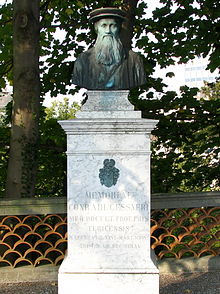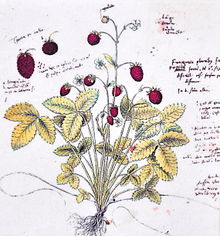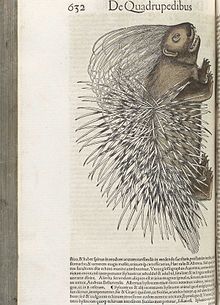- Conrad Gessner
-
Conrad Gessner 
Born March 26, 1516
ZürichDied December 13, 1565 (aged 49)
ZürichNationality  Swiss
SwissFields Botany & Zoology Alma mater University of Strasbourg and University of Bourges Author abbreviation (botany) Gesner Conrad Gessner (Konrad Gessner, Conrad Geßner, Conrad von Gesner, Conradus Gesnerus, Conrad Gesner; 26 March 1516 – 13 December 1565) was a Swiss naturalist and bibliographer. His five-volume Historiae animalium (1551–1558) is considered the beginning of modern zoology, and the flowering plant genus Gesneria (Gesneriaceae) is named after him. He is denoted by the author abbreviation Gesner when citing a botanical name.[1]
Contents
Birth and education
Born and educated in Zürich, Gessner was the son of a furrier. After the death of his father at the Battle of Kappel (1531), he was very short of money. He had good friends, however, in his old master, Oswald Myconius, and subsequently in Heinrich Bullinger, and he was enabled to continue his studies at the universities of Strassburg and Bourges (1532–1533); in Paris, he found a generous patron in the person of Job Steiger of Berne.
Career
 Conrad Gessner memorial at the Old Botanical Garden, Zürich
Conrad Gessner memorial at the Old Botanical Garden, Zürich
In 1535, religious unrest drove him back to Zürich, where he made an imprudent marriage. His friends again came to his aid, enabled him to study at Basel (1536), and in 1537 obtained for him the professorship of Greek at the newly founded academy of Lausanne (then belonging to Berne). Here he had leisure to devote himself to scientific studies, especially botany.
In 1540-1541 he visited the famous medical university of Montpellier, took his degree of doctor of medicine (1541) at Basel, and then settled down to practise at Zürich, where he obtained the post of lecturer in physics at the Carolinum, the precursor of the University of Zürich.
There, apart from a few journeys to foreign countries, and annual summer botanical journeys in his native land, he passed the remainder of his life. He devoted himself to preparing works on many subjects of different sorts.
His great zoological work, Historiae animalium, appeared in 4 vols. (quadrupeds, birds, fishes) folio, 1551–1558, at Zürich, a fifth (snakes) being issued in 1587 (there is a German translation, entitled Thierbuch, of the first 4 vols., Zürich, 1563): this work is the starting-point of modern zoology. Gessner was the first to describe the brown rat and the guinea pig in Europe.[2]
There was extreme religious tension at the time Historiae animalium came out. Under Pope Paul IV it was felt that the religious convictions of an author contaminated all his writings,[3] so it was added to the Roman Catholic Church's list of prohibited books. Gessner was Protestant.[4]
Not content with such vast works, Gessner was also active as a linguist, putting forth in 1555 his book entitled Mithridates de differentis linguis, an account of about 130 known languages, with the Lord's Prayer in twenty-two languages.
In 1556 appeared his edition of the works of Claudius Aelianus. It includes sketches for many well known animals, and some fictional ones, including unicorns and mermaids.
He died of the plague, the year after his ennoblement.
Legacy
To his contemporaries he was best known as a botanist, although his botanical manuscripts were not published (in Nuremberg, 1751–1771, 2 vols. folio) until long after his death, he himself issuing only the Enchiridion historiae plantarum (1541) and the Catalogus plantarum (1542) in four languages. In 1545 he published his remarkable Bibliotheca universalis (ed. by J. Simler, 1574), supposedly a catalogue (in Latin, Greek and Hebrew) of all writers who had ever lived, with the titles of their works, etc. A second part, Pandectarum sive partitionum universalium libri xxi, appeared in 1548; only nineteen books being then concluded. The last, a theological encyclopaedia, was published in 1549, but the last but one, intended to include his medical work, was never finished.
 Fragaria vesca in 'Conradi Gesneri Historia plantarum'
Fragaria vesca in 'Conradi Gesneri Historia plantarum'
Gessner in 1551 was the first to describe adipose tissue;[5] and in 1565 the first to document the pencil.
Among his friends was John Caius, English court physician to the Tudors and second founder of Gonville and Caius College, Cambridge.
To non-scientific readers, Gessner is best known for his love of mountains (below the snow-line) and for his many excursions among them, undertaken partly as a botanist, but also for the sake of exercise and enjoyment of the beauties of nature. In 1541 he prefixed to his Libellus de lacte et operibus lactariis a letter addressed to his friend J. Vogel of Glarus on the wonders to be found among the mountains, declaring his love for them, and his firm resolve to climb at least one mountain every year, not only to collect flowers, but in order to exercise his body. In 1555 he issued his narrative (Descriptio Montis Fracti sive Montis Pilati) of his excursion to the Gnepfstein (1920 m), the lowest point in the Pilatus chain. he aso made the dog
Gessner was posthumously partly responsible for Insectorum, sive, Minimorum animalium theatrum or Theatre of Insects, written jointly by him with Edward Wotton, Thomas Muffet and Thomas Penny.
Gessner was featured on the 50 Swiss francs banknotes issued between 1978 and 1994.
See also
- Bloodhound and Rache for other pictures from Gessner's work
References
- ^ Brummitt, R. K.; C. E. Powell (1992). Authors of Plant Names. Royal Botanic Gardens, Kew. ISBN 1-84246-085-4.
- ^ Freye, H.A., and Thenius, E. (1968) Die Nagetiere. Grzimeks Tierleben. (B. Grzimek, ed.) Volume 11. Kindler, Zurich. pp. 204-211.
- ^ Schmitt, p. 46,
- ^ "Conran Gesner biography". http://www.strangescience.net/gesner.htm. Retrieved 2008-09-17.
- ^ Cannon, Barbara; Nedergaard, Jan (2008-08-21). "Developmental biology: Neither fat nor flesh". Nature 454 (7207): 947–8. doi:10.1038/454947a. http://www.nature.com/nature/journal/v454/n7207/full/454947a.html. Retrieved 2011-05-24.
 This article incorporates text from a publication now in the public domain: Chisholm, Hugh, ed (1911). Encyclopædia Britannica (11th ed.). Cambridge University Press.
This article incorporates text from a publication now in the public domain: Chisholm, Hugh, ed (1911). Encyclopædia Britannica (11th ed.). Cambridge University Press.
- Biographies were written by J. Hanhari (Winterthur, 1824) and J. Simler (Zürich, 1566).
- Pyle C. M. (2000). "Conrad Gessner on the Spelling of his Name". Archives of Natural History 27: 175–186.
- Idem, “Conrad Gessner,” in Encyclopedia of the Scientific Revolution from Copernicus to Newton, ed. Wilbur Applebaum, New York, Garland, 2000, 265-266.
- Idem, “Conrad Gessner” in Europe 1450-1789: Encyclopedia of the Early Modern World, Ed. Jonathan Dewald, Charles Scribner’s Sons, New York, 2004.
External links
- Theatre of Insects
- Online version of Insectorvm Sive Minimorum Animalivm Theatrvm from GDZ
- Conrad Gesner's Thierbuch, Vogelbuch, Fischbuch, Schlangenbuch, De Scorpione - Reproductions of books.
- Urs B. Leu: Konrad Gessner in German, French and Italian in the online Historical Dictionary of Switzerland.
- Page through a virtual copy of Gessner's Historiae Animalium
- The Natural History of Horses, with Memoir of Gesner by Charles Hamilton Smith
- Images from Icones Animalium... 1560.
Categories:- 1516 births
- 1565 deaths
- 16th-century Latin-language writers
- 16th-century Swiss physicians
- Botanists with author abbreviations
- Christian Hebraists
- Deaths from bubonic plague
- People from the canton of Zurich
- Swiss botanists
- Swiss linguists
- Swiss mountain climbers
- Swiss naturalists
- Swiss zoologists
Wikimedia Foundation. 2010.

